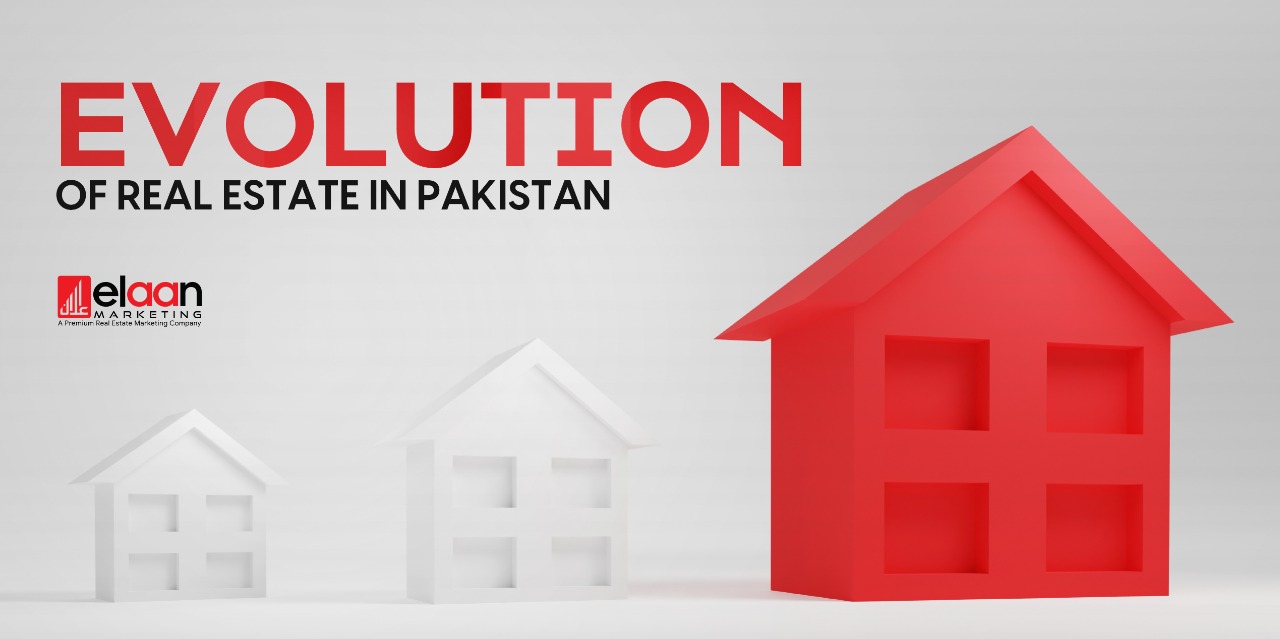Evolution of Real Estate in Pakistan
What is the Origin of ‘Real Estate’?
The term ‘real estate’ was first introduced in the year 1666 in London and has been continued to this day. Real estate mainly explains any ownership or business that involves an idle piece of land, a building, a plot, a house, a shop etc. In simpler words, answer to the question ‘What is Real Estate?’ If you own a piece of land regardless of anything constructed on it, that land would be referred to as ‘ real estate’. Legally, real estate explains a property or all of its ‘existing’ or ‘fixed’ components.
If we take the two parts of the word separately, we find that the first element, ‘real,’ comes from the Latin language and means ‘actual’ or ‘genuine’, while the second component, ‘estate,’ translates as a phrase that is used to refer to property that is held.
Global History of Real Estate Industry
The late 19th century is when the real estate sector first emerged, but it wasn't until the early 1900s that it started to take on its current form. In order to cover more real estate issues, the National Association of Real Estate Exchanges was founded in Chicago in 1908 as the National Association of Realtors.To include investment in real estate, flipping, and online sales, the business underwent a series of evolutionary adjustments.
History of Real Estate Investments
Real estate has been a very attractive investment for many people due to fluctuating property values. However, the idea of investing in real estate is not new. In the early days of the United States, renting land to tenants became popular. In the real estate history timeline, this was followed by a boom in real estate following World War II and the Great Depression. In 1960, the federal government passed legislation allowing investors to benefit from real estate investment trusts, opening the door for people to purchase and resell homes for a profit. But real estate investing didn't really take off until the 1980s crisis.
History of Real Estate Market in Pakistan
Pakistan’s real estate market paced up when areas like Nursery, PECHS, Tariq Road, and Sindhi Muslim Society started gaining population’s attention during the 1950s. With the housing society culture’s introduction following the market, real estate experienced an economic boom. Initially the prices of the plots in housing societies were considerably low. However, with the passage of time, the prices started rising when the citizens of Pakistan acknowledged the perks of owning such property. The concept of owning valuable assets such as properties and gaining returns on them spread across the country and the real estate market made its way to one of the most progressing businesses of that time.
Real estate development became one of the economical assets of Pakistan as the sector was industrialised for residential, commercial and corporate units alike.
Rise and Fall of the Real Estate Market over the years
If we take a quick overview of Pakistan’s real estate history timeline, we find that the real estate market received a boost during 1973-74 when the Amnesty Scheme was introduced by ZA Bhutto and lasted till 1997. However, the real estate market of Karachi faced a terrible crash as a result of post-election riots along with the notorious flood in DHA. This fall of the market was faced continuously by the real estate sector until 1982.
After the Afghan war, Pakistan became the centre of attention and gained a considerable amount of financial and moral aid from countries around the globe, which inevitably provided an uplifting hand to the real estate market and the rise was seen from 1982-88.
After the unexpected death of then-President, Gen Zia ul Haq, the real estate market experienced a drop once again from 1988 till 1992. The condition of the market went through an irregular path during 1992-94 but was soon followed by a raise from 1994-97. Real estate witnessed a tremendous amount of development during these years before it suffered a depression in the late 1997-2001.
After the 9/11 incident, Pakistan's real estate market saw a significant rise. The market's recovery following the 9/11 attack shattered all of its previous heights. This expansion of the real estate sector distanced the average Pakistani from the idea of home ownership. In the early 2000s, the steep price increase prevented many serious buyers from buying real estate. In 2005, the market collapsed due to the subsequent recession.
This downturn persisted until June 2010. According to economists, the sky-high prices of real estate were a major contributing factor in this recession. Beginning in July 2010, the market started to slowly recover. A boom in this repair process began in 2012 and continued through November 2015. Overpricing was once again a factor in the collapse. After a modest decline in November 2015, the market once more increased to smash the previous 8, and 9-year milestones.
Evolution of real estate in Pakistan
Before some of the modern real estate trends took over, with the history of property ownership, Pakistan’s real estate was merely limited to individual residential and commercial units, along with independent corporate complexes. In 1963, The first high-rise building in Pakistan was developed in Karachi; Habib Bank Plaza, was the tallest building in Pakistan and was the first step towards modern architecture.
Apartments have always been mostly restricted to Karachi, whereas residents in Lahore and Islamabad have always chosen to purchase a property that is already for sale. However, as cities become overcrowded as a result of fast urbanisation, land prices are surging, and the trend toward apartment purchase in these places is also picking up speed.
It wasn’t until around 1997 that the first gated community was introduced in Pakistan and was called ‘Bahria Town’. It exemplified the contemporary living standards and brought about an innovation in the history of Pakistan’s real estate trends. With the industry rapidly growing, some of the new trends in Pakistan are on par with the global standards of construction and architecture. The newly introduced real estate trends include:
High-rise Buildings
The skylines of Karachi, Lahore, and Islamabad, three of Pakistan's most economically active cities, are changing quickly as a result of development officials' recent approval of high-rise construction. The Lahore Development Authority (LDA) recently released new policies that encourage the development of high-rise buildings in metropolitan areas. Another significant step came afterward when the Rawalpindi Development Authority (RDA) announced comparable adjustments for its domain.
The building and development industry has profited from a surge in high-rise construction. Suppliers of raw materials are doing better business, while labourers, architects, and engineers are finding new jobs. The Pakistani real estate industry is likewise preparing to build towers. Innovative construction and design techniques are required for structures that exceed 150 metres in height.
Gated Communities
The idea of gated residential communities is flourishing in Pakistan, along with high-rise residences and mixed-use complexes. Housing societies have transformed several of the nation's major cities' abandoned suburbs into tranquil yet ultramodern residential communities. It wouldn't be incorrect to claim that the gated community developments in Karachi, Lahore, and Islamabad have predominantly set the groundwork for Pakistan's progressive lifestyle.
Many investors and stakeholders have now turned their attention to this new and quickly developing property trend in light of the rising popularity of the idea of gated housing communities in the nation. Two of the best examples in this regard are Etihad Town in Lahore and Etihad Garden in Rahim Yar Khan. These new complexes have all the amenities and conveniences of today, just like other substantial housing developments across the nation. They're meant to provide you with all the benefits of living in a gated community.
Villa-style Homes
The day when villas could only be described as enormous mansion-style homes has long since passed. The size of homes has decreased recently due to attention being paid to sustainable development and construction methods. Villa-style homes are currently being built in practically every other housing plan across the nation, making the most efficient use of available space.
The majority of these dwelling units in a specific residential scheme are the same size and are uniformly created with current layouts to assure top-notch and aesthetically beautiful urban arrangements. It might be a single-story or multi-story building surrounded by modern neighbourhood amenities. Small-sized villas are now being included in well-planned gated communities in some of the main Pakistani towns to provide a luxurious and contemporary living experience on a budget.
Villa-style homes are currently among the biggest real estate trends in Pakistan, and for good reason. They are being built all throughout the nation. When you invest in contemporary villas, you may have it all without breaking the bank, from a highly safe setting to luxurious living experiences.
Mixed-use Developments
One of the most well-known real estate trends in Pakistan over the past few years has also been the idea of mixed-use construction. It is a kind of real estate development, as the name implies, that houses well organised corporate, residential, and occasionally even commercial buildings all under one roof.
Mixed-use complexes are often located in the metropolitan centres of the country's main cities, which are typically expansive and dense. Another incredibly essential feature contributing to this property trend's great appeal in Pakistan is the existence of indoor facilities and a secure atmosphere. This is one of the many reasons why this property trend is quite popular there.
The second-largest city in Pakistan, Lahore, has emerged as a hub for mixed-use development. Numerous mixed-use structures are currently being built throughout the city.
The development of a massive project like The Magnus Mall and Twin City Towers is a clear indication that the idea of mixed-use development has emerged as one of Pakistan's most promising real estate trends that will aid in the development of sustainable urbanism for the future of our cities.
Hotel/Serviced Apartments
The construction of hotel apartments and serviced apartments is another quickly developing real estate trend in Pakistan. They are now present in practically all of the other major American cities, just like other kinds of properties.
There are a lot of key differences between hotel apartments and residential apartments. The fact that hotel flats are designed and constructed to provide you with an opulent and fully-furnished living space is perhaps the aspect that stands out the most among these advantages. You would be provided with a completely furnished apartment in addition to high-quality individualised services.
Across the nation, there are numerous different real estate projects that include hotel apartments and serviced apartments and are planned to be managed by renowned names in this industry sector, including Adara Suites in Lahore, Space Luxury Rental Suites in Rawalpindi, Pakiza INN Apartments in Bhurban and Swiss Suites, located in both Kuza Gali, Ayubia and the magnificent location of Bhurban.
Townhouses
The concept of a townhouse has been around for quite some time. The building of townhouses is a time-honoured tradition that can be found in a diverse variety of countries. However, this trend in real estate has only recently begun to emerge in our country.
The core design of townhouses is completely compatible with the concept of sustainable urban development. Despite the fact that the footprint of a property of this type is typically quite small, it often contains multiple levels that provide additional space for living purposes. Around the country, brand-new housing developments are beginning to incorporate townhouses at a higher rate than in the past.
They support the idea of communal living in addition to giving a residential development an ultramodern appearance. A neighbourhood would be more connected and socially engaged if there were dozens of such small-sized dwelling units on a single street, for instance. Townhouses designed using contemporary architectural methods feel no less luxurious than villa residences, especially if they feature expansive floor plans and modern accents.
A townhouse in a gated community with security could be the ideal place for a small family to live because it is affordable yet comfortable.
Low-cost Housing Schemes
Because of the dramatic rise in the country's overall population in recent decades, Pakistan is home to a number of the most populous cities in the world at the present time. As a direct consequence of this, there is currently a substantial disparity between the supply of homes available and the demand across the country. The shortage of available homes in Pakistan prompted the Pakistani government to initiate the Naya Pakistan Housing Project.
This affordable housing initiative, which is being supported by the government, has already begun its rollout across the country. Families from the lower middle class, middle class, and working class are the primary focus of this initiative, which aims to construct five million residential units. Not only do initiatives that provide affordable housing help alleviate the housing shortage in the country, but they also have many other positive economic effects.
Real Estate Market’s Challenges in Pakistan
Pakistan's market is confronted with a variety of issues in both the commercial and residential real estate sectors as a result of the industry’s expansion. Keeping in mind the history of property ownership in Pakistan, the residential rental business is not as established due to the cultural preference for ownership, therefore purchasing is the most common form of housing acquisition.
A lack of financial resources and a high level of bureaucracy within Pakistan's governmental institutions are two difficulties faced by real estate developers, both of which contribute to lengthy approval procedures and delays. Despite significant expansion in both the commercial and residential real estate markets in Pakistan, the sector continues to face a number of difficulties.
Future of Real Estate in Pakistan
Both buyers and realtors are demanding for real estate in desirable areas of cities like Karachi, Lahore, and Islamabad. Such properties are already costing in the millions of dollars or higher. In areas like Bahria Town, Gulberg, or Defense, a basic one Kanal house might cost anywhere between 4 crore and 7 crore. Prices have increased so quickly that they are now almost five times what they were a few years ago. Owners of the property are merely holding off on selling it in order to wait for prices to rise even further. It is still to be seen whether this strategy of delaying and turning away prospective customers would be successful in the long run.
What is Real Estate’s Influence on Other Industries?
More than a hundred industries are directly and indirectly related to Pakistan's fastest-growing sector, real estate. Along with the development business, other industries will grow due to the real estate boom. For local and international investors looking for a place to locate their interests, it is the best investment option. However, while real estate has grown, there have also been many significant obstacles, fragmented regulatory frameworks, lack of affordable housing, a slow uptake of technology, a loss of transparency, and a lack of resiliency.







